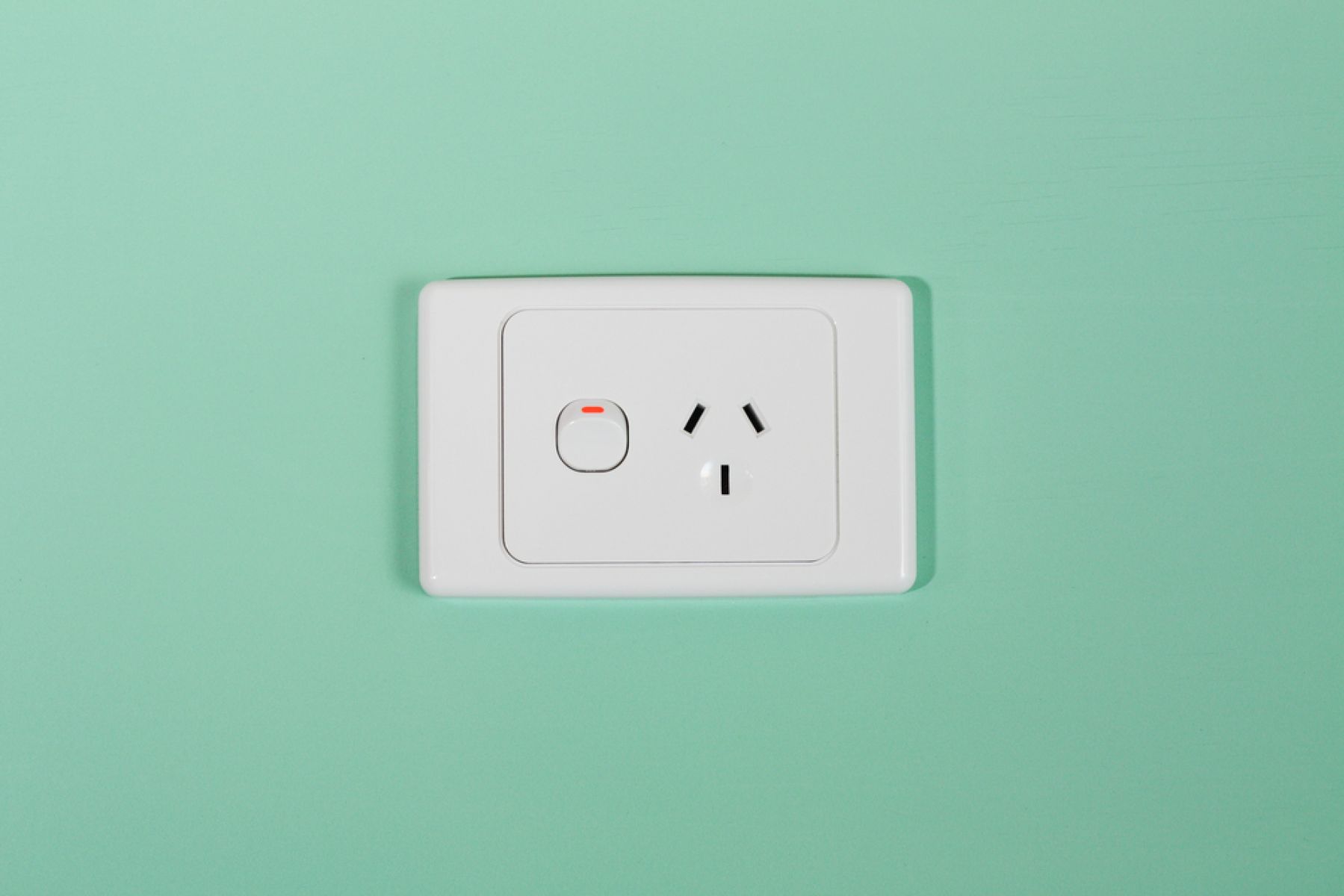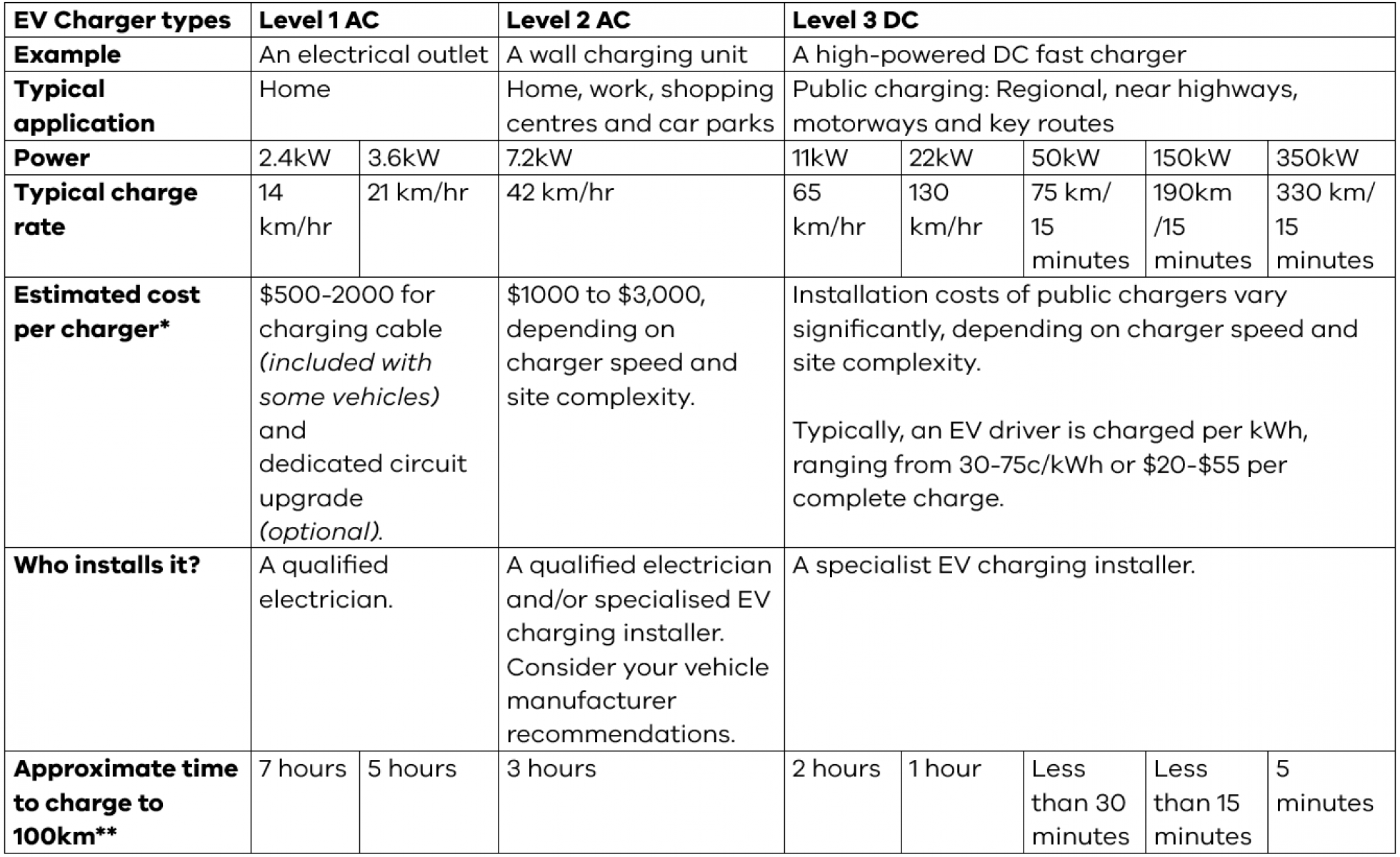On this page:
As we strive for a 2030 target for half of all new light vehicle sales to be zero emissions, Victorians will need greater access to electric vehicle (EV) charging, including:
- private chargers in the home or workplace
- public chargers at destinations and along your journey.
This page will help you understand your options and the steps to installing charging equipment for:
- households and businesses
- owner corporations
- councils.
Choosing the best EV charger
Choosing an EV charger will depend on what is both cost-effective and convenient. Charging options will vary in price, charging speed and complexity to install. The best choice for you will also depend on your situation, home, EV and/or your business.
- Different travel needs will require different charging equipment. The average Victorian drives around 38km a day. Most EVs available today can travel at least 300-400km in a single charge. Charging at home using a standard electrical outlet (level 1 charging) will meet most people’s daily travel needs.
- Can you maximise solar usage to charge your EV? Savings are even larger when charging an EV with free electricity generated by your solar. For those without solar, there are EV-specific electricity plans with cheap or free ‘super off-peak’ rates available in the middle of the day, taking advantage of abundant and clean solar resources.
- If you can, charge at your work, along your commute or at public charging locations. You can visit plugshare.com to see what public charging locations are available near you. It is important to consider the cost when using public charging stations. Some public chargers may require you to bring your own portable charging cable.
- The right EV charger for you will depend on if you live in an apartment or house with off-street parking. People without access to off-street parking will likely be unable to charge at home. You will need to identify readily available public charging.
- Your home’s wiring may need updating to support higher level charging. If you live in an older building, consider talking with a qualified electrician or EV charger installer.
- Are you planning other electrical works, like electrifying your home? If so, it may be worth considering upgrading your service connection and switchboard at the same time to accommodate these changes if you intend to purchase an EV in the future.
- Renters may need to discuss installation of a dedicated power outlet (for level 1 charging), or installation of a dedicated (level 2) charger with their rental provider.
- Whether you have a battery electric or plug-in hybrid electric vehicle, your battery size and travel needs will impact your charging needs.
- Your vehicle’s maximum charging rate will inform how fast you can charge at higher rates. You can safely charge your EV at any of the three levels, but some vehicles can charge faster than others.
- The number of EVs you need to charge and how far they travel will affect the level and number of chargers needed for your business.
- Different businesses will have different charging needs. This includes if you can slow charge overnight or if you need fast charging during the day to get back on the road.
Types of EV chargers
Level 1 charger – wall socket charger

Level 1 charging is the simplest type of EV charging, which:
- uses a standard 230-volt AC power point and a charging cable. A cable may be supplied with your EV, but some models do not come standard with this charger.
- does not require any modifications to your home or business. However, you can make minor electrical upgrades to increase your charging speed, without installing a dedicated charger.
- provides 14 to 21 kilometres of range per hour. This can deliver the power needed for the average daily travel needs when charged for 3–4 hours. Most drivers only need frequent, smaller charging sessions.
- does not have a function to set the charging time for your vehicle. This feature is available in many vehicle's internal charging settings.
Note: The Electric Vehicle Council recommends installing a dedicated circuit for your vehicle. This can help prevent overloading existing circuits in the home. If installing a dedicated circuit, it is worth considering a 15amp outlet and charger, instead of a standard 10amp circuit. This will increase your charging rate by 50% and decrease charging time by a third. Speak to a qualified electrician for a tailored quote on installation costs.
Level 2 charger (fast charger) – dedicated wall charger

Level 2 charging is a more powerful and complex type of EV charging, that:
- requires dedicated circuitry and dedicated home charger, or ‘wall box’.
- supplies at least twice the power of level 1 - providing between 42 and 65 kilometres of range per hour for most vehicles. This increases your power output and reduces the time taken to fully charge your vehicle.
- may allow you to control your charging sessions through a dedicated app. Some chargers have smart capabilities which help optimise charging. You can schedule charging to happen during off-peak periods or to make the most of your solar power.
- likely requires modifications to your home, meaning higher costs than Level 1 charging. Costs include the charger itself and labour costs. The total cost will depend on your home design, wiring accessibility and other factors, which may include a switchboard upgrade.
- can be either single-phase or three-phase. Most houses in Victoria are single-phase. Level 2 charging on a single phase will meet most people’s daily commute needs.
Note: There are higher installation costs involved in upgrading your house to three-phase. Some new houses may already have three-phase connections, particularly fully-electric homes. It may be worth upgrading to a three-phase connection if you are planning for multiple EVs in the future. Speak to a qualified electrician for advice and a quote on upgrading your connection.
Level 3 charger – public rapid or ultra-rapid charger

This type of EV charger is typically found in public or commons areas, or at public charging stations where long-distance drivers require a full charge. Level 3 charging uses high power electricity, capable of fully charging an EV in 20 to 45 minutes. This requires significantly higher installation costs.
As a result, this is largely impractical for residential settings outside shared facilities in large apartment complexes.
Maximise the benefits from charging your EV
There are many perks of owning an EV, including reduced running costs and both environmental and grid benefits. How and when you choose to charge can help maximise these benefits.
A dedicated charger with smart charging capabilities is the easiest way to achieve this. However, there are other ways to do this if a smart charger is not the best option for you. Many EVs enable you to pick set charging times on the dashboard menu. Plus, you can always plug in your EV when you want the vehicle to charge.
Running costs
Charging your vehicle at home means you can access cheaper electricity rates. This increases your savings from running your vehicle.
Choosing the right electricity retail plan will help you maximise the benefits of owning an EV. Certain plans provide lower-cost electricity costs during off-peak times. This means, a lower energy bill, reduced environmental impact and reduced demand on the grid at peak times.
The benefits are even greater if you have solar panels. This means you can charge your car with cheaper renewable energy that benefits your savings and the environment.
Environmental
EVs have zero exhaust emissions. This makes them better for the environment and our health than fossil-fuelled vehicles. Research shows that even if an EV is charged by grid electricity (including coal-fired sources), it will still improve overall net emissions.
The cleanest and cheapest way to charge your EV is by using a renewable energy source, such as solar. However, choosing an energy retail plan that rewards you for charging at off-peak times, when there’s more renewable energy available, further reduces emissions from EV charging.
The electricity grid
Charging outside peak times creates cost savings for both EV drivers and all energy consumers. It also benefits the electricity grid. The widespread rollout of rooftop solar systems means that during the day, there’s sometimes more power than we need in some areas. EVs can help the grid by using some of this extra energy available during the day.
We are also planning for EVs to work as another energy source when parked in your garage. This is known as vehicle to home (V2H) or vehicle to grid (V2G). In the future, EVs could store electricity during the day and supply electricity during periods of high demand or limited supply – helping to meet the energy needs of households and businesses. For example, current battery sizes can power the average home for up to 3 days in the evenings and some up to a week. In a blackout, your EV could power your home.

*Installation costs will vary depending on labour required, your house design, wiring accessibility and other factors. Contact a qualified electrician for a quote to understand your installation costs.
**Charge range may vary depending on the charging station and the vehicle's maximum charging rate. Most EVs available on Australian market are only able to charge up to 11kW for Level 2 AC charging.
Smart charging
Smart charging enables scheduled or controlled charging, often through a mobile app. This may be during times when there is less demand on the grid or more renewable electricity available.
Smart charging:
- can be applied to level 2 chargers in the home or workplace
- requires a wired, Wi-Fi or Bluetooth connection. This allows the charger to communicate with an app or building load management system
- is preferred over a ‘simple charger’ to help manage your energy costs
It is important to consider whether you need smart charging capabilities to maximise the benefits of owning an EV.
Page last updated: 28/08/24
